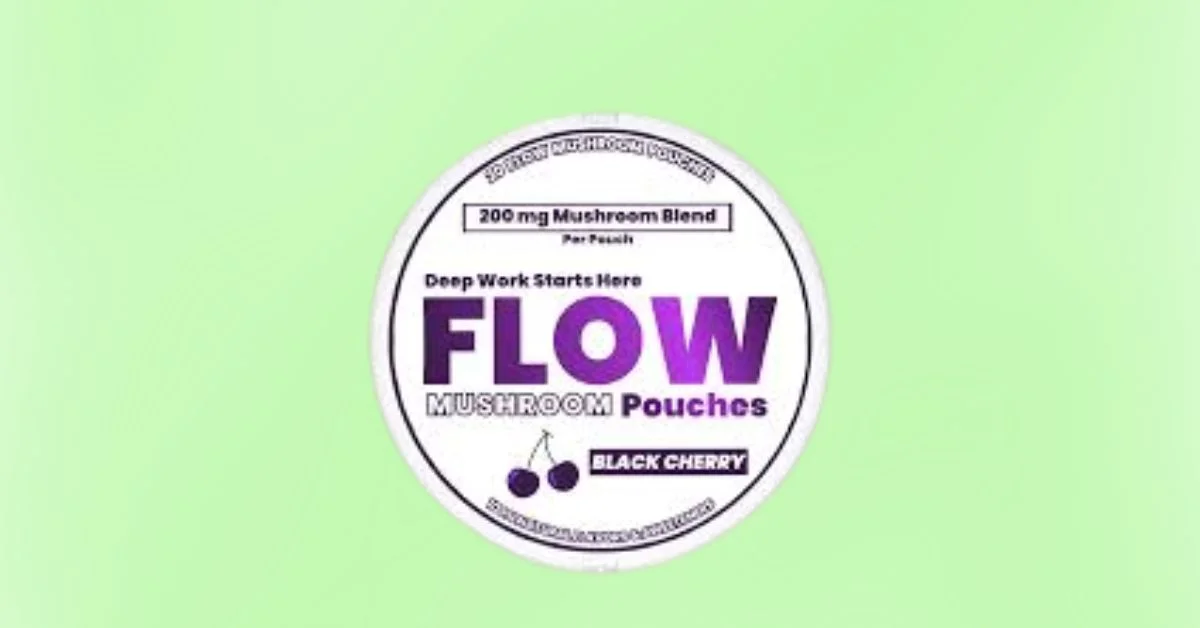Flow pouches are reshaping how nicotine is consumed, marketed, and understood. Tucked discreetly inside the upper lip, they’re designed for adult users seeking a smokeless, spit-free, and odor-free experience without the social and health baggage of traditional tobacco. Often flavored and available in varying strengths, flow pouches have emerged as a less intrusive and more controlled form of nicotine intake—offering convenience, reduced mess, and a veneer of wellness-friendly appeal.
Unlike combustible cigarettes or even snuff and chewing tobacco, flow pouches contain no actual tobacco leaves. Instead, they rely on synthetic or purified nicotine suspended in plant fibers. For curious consumers, transitioning smokers, and harm-reduction advocates, flow pouches represent a new category: a product that’s both addictive and cleaner, both indulgent and manageable.
In this article, we examine what flow pouches are, how they function, their rising role in nicotine consumption culture, and what their increasing popularity signals about the future of smokeless alternatives.
What Are Flow Pouches?
Flow pouches are small, teabag-like packets filled with nicotine, plant fibers, sweeteners, and flavorings. Designed to be tucked between the gum and upper lip, they release nicotine gradually into the bloodstream via the mucous membranes in the mouth. Unlike snus or chewing tobacco, they do not contain tobacco leaf, nor do they require spitting.
The term “flow” typically refers to the smooth, consistent release of nicotine. In these pouches, that flow is engineered to mimic the slow uptake associated with traditional tobacco but with none of the combustion, smoke, or visible usage. They’re discreet, fast-acting, and clean—three adjectives that help explain their meteoric rise, especially among health-conscious nicotine users and former smokers.
What Makes Flow Pouches Different?
The pouch category has evolved rapidly, and flow pouches represent the most refined iteration so far. Here’s how they differ from other smokeless or oral nicotine products:
- No Tobacco Leaf: Unlike snus or dip, flow pouches use a tobacco-free nicotine extract or synthetic nicotine.
- No Spit Required: They do not generate the need to spit, making them more acceptable in social settings.
- Controlled Dosage: Each pouch contains a specific amount of nicotine, helping users regulate intake more precisely.
- Discreet Use: There’s no smell, no exhaled vapor, and no device, which makes them nearly invisible in public.
- Long-Lasting Flavor: High-quality pouches offer sustained flavor and mouthfeel, from mint to fruit to coffee variations.
Their portability and subtlety are key to their appeal. For users trying to avoid lighting up or drawing attention, flow pouches provide a no-fuss experience.
What’s Inside a Flow Pouch?
Though brands differ, most flow pouches contain a core set of ingredients:
- Nicotine (synthetic or derived): The primary active ingredient, ranging from 2 mg to 12 mg per pouch.
- Plant Fibers (e.g., cellulose): Serve as a filler material and carrier for nicotine and flavors.
- pH Buffers (e.g., sodium carbonate): Help optimize absorption by maintaining an alkaline environment in the mouth.
- Flavorings: Mint, citrus, berry, coffee, and other varieties tailor the experience.
- Sweeteners: Typically non-caloric agents like xylitol or sucralose, used to reduce bitterness.
This ingredient list reflects a broader trend in consumer wellness products—stripped-down, minimal formulations that aim for clarity and function without the complications of burning or metabolizing smoke.
How Do Flow Pouches Work?
Once inserted into the upper lip, the pouch begins to moisten. Nicotine dissolves into saliva and is absorbed through the gum’s mucous membranes, entering the bloodstream without passing through the lungs. The onset is relatively fast—users typically feel effects within 5 to 10 minutes, with peak absorption around 20 to 30 minutes.
The pouch remains active for about 30–60 minutes. After that, it’s discarded in a wrapper or a designated trash container. No spitting, no ashes, and no odor.
This clean pharmacokinetics is one of the biggest appeals for health-conscious users: flow pouches skip the harmful delivery system (smoke) but preserve the stimulant effect (nicotine).
Why Are Flow Pouches So Popular?
1. They Offer Harm Reduction
While not harmless, flow pouches eliminate many of the known toxins associated with smoking or vaping. By removing combustion from the equation, users avoid inhaling carcinogens, tar, and volatile compounds.
2. They’re Convenient and Discreet
You can use them at a meeting, on a plane, or in a classroom—anywhere you wouldn’t smoke or vape. Their ease of use and low visibility make them ideal for modern life.
3. They Appeal to Ex-Smokers
Many smokers who quit cigarettes find vaping either too similar or too complicated. Flow pouches offer a middle ground: satisfying, simple, and ritualistic without being conspicuous.
4. They’re Flavored and Customizable
From peppermint to coffee to mango-chili, flow pouches come in increasingly sophisticated flavor profiles. Some brands offer adjustable strengths, helping users taper down or control their intake.
Who Uses Flow Pouches?
The typical flow pouch user skews younger than traditional tobacco users but older than typical vapers—usually between 25 and 45. This cohort values control, convenience, and perceived safety. They’re often working professionals, athletes, or tech-savvy consumers seeking a way to manage stress or stay focused without smoking.
Additionally, users fall into several categories:
- Ex-smokers: Seeking a smoke-free yet satisfying alternative.
- Current nicotine users: Rotating between vapes, gums, and pouches.
- Caffeine reducers: Using nicotine for focus in place of coffee or energy drinks.
- Travelers or commuters: Who need a quick hit without paraphernalia.
This new demographic sees flow pouches less as a vice and more as a functional stimulant—akin to nootropics or microdosed supplements.
Health Considerations
Flow pouches are not without risks. Nicotine is still a highly addictive compound, and overuse can lead to dependency, elevated heart rate, and other cardiovascular effects. However, compared to cigarettes or vaping, pouches present a reduced-risk profile because:
- They contain no smoke.
- There’s no lung exposure.
- They produce no secondhand byproducts.
- Many are tobacco-free, avoiding tobacco-specific nitrosamines.
Still, they are not safe for non-nicotine users, adolescents, pregnant women, or individuals with heart conditions. Regulation is also catching up—governments are beginning to classify them alongside other nicotine products, which may impact accessibility.
The Rise of Synthetic Nicotine
One innovation pushing flow pouches forward is synthetic nicotine—a lab-created version of nicotine not derived from tobacco plants. It offers several advantages:
- Purity: Fewer contaminants or byproducts from agricultural processing.
- Regulatory avoidance: Some companies use it to sidestep FDA restrictions on tobacco-derived products.
- Perception: Users often view synthetic options as cleaner or more ethical.
Synthetic nicotine also aligns with the broader biotech trend of removing nature’s inefficiencies in favor of lab-controlled precision.
Environmental and Social Impacts
Flow pouches don’t require batteries, coils, pods, or packaging waste typical of vaping. But they do produce their own environmental footprint:
- Most pouches are non-biodegradable.
- Flavored options may attract minors, leading to concerns of youth uptake.
- Discarded pouches can become litter.
Brands that succeed in the next phase of growth will likely be those that integrate sustainable packaging, bio-based fibers, and transparent labeling. The challenge now is to maintain the balance between innovation and responsibility.
Flow Pouches vs. Other Nicotine Products
| Product | Tobacco-Free | Discreet | Spit-Free | Smoke-Free | Contains Flavor |
| Flow Pouches | ✅ | ✅ | ✅ | ✅ | ✅ |
| Cigarettes | ❌ | ❌ | ✅ | ❌ | ❌ |
| Vapes | ✅/❌ | ❌ | ✅ | ✅ | ✅ |
| Nicotine Gum | ✅ | ✅ | ✅ | ✅ | ✅ |
| Snus/Dip | ❌ | ❌ | ❌ | ✅ | ✅ |
This chart reflects the functional advantage of flow pouches across many metrics. They occupy a unique spot in the nicotine landscape—a product that is as much about practicality as it is about pleasure.
The Future of Flow Pouches
Flow pouches sit at the intersection of wellness, biotechnology, and harm reduction. Their discreet nature and simplified usage model suggest that they are more than a trend—they could become a standard. Here’s what we might see in the near future:
- Regulatory clarity: Governments worldwide will introduce more concrete labeling and age-restriction frameworks.
- Ingredient transparency: Clean-label pouches will dominate as users demand to know what they’re consuming.
- Functional formulations: Expect additions like caffeine, B vitamins, or adaptogens for enhanced use-cases.
- Sustainability focus: Recyclable or biodegradable pouch designs may gain traction.
More broadly, flow pouches signal a shift in consumer behavior: a willingness to engage with stimulants on their own terms, minus the smoke, stigma, and side effects.
Conclusion
Flow pouches represent a modern evolution in nicotine consumption. By removing tobacco, smoke, and mess, they offer a controlled, discreet, and potentially reduced-risk experience that aligns with today’s lifestyle preferences. Whether they’re a stepping stone to quitting altogether or a long-term alternative to more harmful products, flow pouches are transforming the narrative around nicotine—from dirty habit to managed supplement.
For adult users exploring new nicotine options, flow pouches provide a practical, portable, and evolving solution. Their continued innovation will depend not only on flavor or buzz—but on how responsibly they are produced, marketed, and consumed.
FAQs
1. Are flow pouches safer than smoking?
Yes, flow pouches eliminate harmful combustion products like tar and carbon monoxide, but they still deliver addictive nicotine.
2. Can I use flow pouches to quit nicotine?
They can be used to taper off nicotine gradually, but they are not designed as cessation aids like patches or gums.
3. How long does a pouch last?
Most users keep a pouch in for 30 to 60 minutes. The effect may last longer, depending on nicotine strength and personal tolerance.
4. Are they legal everywhere?
In most regions, yes—but regulations vary. Some countries or states may have age restrictions or classify them as tobacco products.
5. Do flow pouches stain teeth?
They generally do not stain teeth, especially compared to tobacco products, but long-term use can still affect oral health.
For more information, click here.









